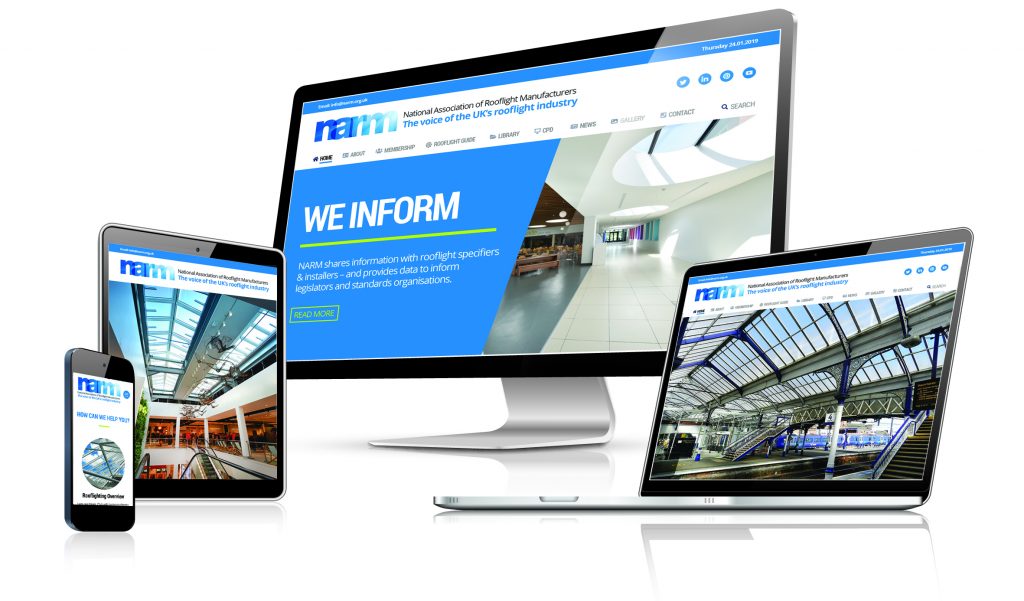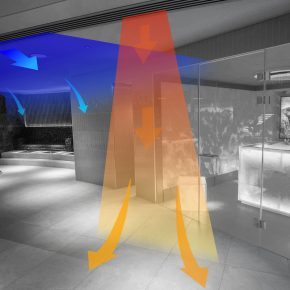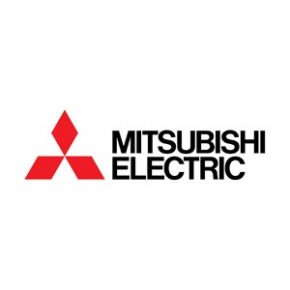
NARM: The quiet revolutions in rooflighting… and the people behind it
The following article is a look behind the scenes at NARM, the National Association of Rooflight Manufacturers…
The last two decades have seen huge advances in the design and application of rooflighting, bringing important advances in building performance and safety.
Many of these have been the result of intense R&D efforts by leading manufacturers. Behind them has been one supporting organisation that’s driven the changes in UK standards & legislation that have made these improvements a day-to-day reality across all sectors of the construction industry and to the wider public.
NARM, the National Association of Rooflight Manufacturers, represents manufacturers and suppliers of all types of rooflights and has played a pivotal role in establishing the effects of rooflighting on building performance and in the development of rooflight standards which protect the marketplace from potentially poorly performing products – as well as promoting best practice among specifiers and installers.
Recognised as the UK’s leading independent and impartial authority on rooflighting, NARM’s Technical Committee comprises a team of leading experts, each coming from within NARM member companies, to represent the Association. Their work underpins many important developments and continues to inform and support the industry…

The sustainability revolution
Soon after the NARM’s formation in the late 1990s, independent research1 by the Association showed minimal losses in thermal insulation brought about by the installation of rooflights are greatly offset by the energy savings resulting from a lesser demand for electric lighting.
Recognising the potential for lower carbon emissions resulting from reduced requirements for electric lighting, a NARM campaign was launched to bring these findings to a wider public, using the slogan: For a smaller carbon footprint, add more rooflights.
Since then, NARM has also been instrumental in collecting, analysing and interpreting rooflighting data upon which the evolving rooflighting requirements in The Building Regulations Approved Document L (Conservation of fuel & power), are based.
Further studies by NARM highlight means by which solar overheating in buildings can be controlled, and the potential for greater energy savings through the integration of automatically controlled electric lighting, with natural daylighting.
Thanks to NARM’s pioneering work in the field, the sustainability benefits of increased natural light levels are now widely understood and applied across the built environment.
Today, NARM’s freely available on-line Technical Library contains a wealth of impartial, up-to-date information covering the subject of energy performance in respect of glass, thermoplastic and GRP rooflights.
The safety revolution – for roof workers
Since its inception, NARM has focussed considerable resources on improving the safety of roof workers.
Working on roofs is a high-risk activity because it involves work at height – and falls through fragile materials, such as aged rooflights and asbestos cement roofing sheets, have historically accounted for a high number of deaths and injuries.
To address this issue, the ACR[M]001 ‘Red Book’ test2 was developed by the Advisory Committee for Roofwork (now Advisory Committee for Roofsafety), drawing on data supplied by NARM – an ACR member organisation. This defines a test for non-fragility which can be applied to any roof assembly, intended to indicate whether the roof can support the instantaneous loads imposed by a person falling or stumbling onto it.
It is not a product test but products such as rooflights can be tested as part of a roof assembly. It sets a minimum standard for non-fragility and all professionals involved with roofing should be familiar with it. The Health and Safety Executive and many other prominent roofing trade associations are also member organisations of ACR.
NARM’s on-line Technical Library contains a number of documents covering non-fragility in respect of rooflights, including a handy ‘Quickguide’, which outlines the key points of the ACR[M]001 test and classifications.
The safety revolution – for building occupants
During the last year, NARM has launched a campaign3 to support the requirement for laminated inner panes on glass rooflights for important safety reasons, bringing pressure on the British Standards Institute for a regulatory amendment.
Current British Standards still permit the use of toughened glass (non-laminated) for inner panes of glass rooflights in some instances, bringing the risk of shattering and falling glass into the room below.
Using laminated glass inner panes significantly reduces this risk and is the reason behind the NARM campaign to ensure all glass rooflights have laminated inner panes, following a number of concerning incidents involving poorly designed or installed glass rooflights (without laminated inner panes).
A number of technical documents by NARM relate to fire safety, including a new ‘Quickguide’ entitled ‘Definition of geometric free area for Smoke Vents4’, published in early 2021.
Continuing progress on many fronts…
The NARM Council, committees and working groups meet regularly on-line, to address current issues and drive new initiatives. As examples, the Association is currently consulting its membership regarding the CPA’s CCPI (Code for Construction Product Information).
NARM has also recently published a post-Brexit Statement on the Construction Products Regulation5, and the changes to Product Standards, CE marking and the introduction of UKCA and UKNI marking of products. This document, along with many others, is also available on the NARM website.
NARM represents leading manufacturers and suppliers of all types of rooflights into the UK market and works closely with a number of organisations and other trade associations. NARM is a member of the RIBA CPD Providers’ Network; The Construction Products Association and Eurolux, the European trade association representing rooflight suppliers.
Sources
1 Daylighting and Solar Analysis for Rooflights: Dr. J. Mardaljevic & Prof. K. Lomas, De Montfort University’s Institute of Energy and Sustainable Development
2 https://www.the-acr.org/publications/the-red-book/
3 https://www.narm.org.uk/products/glass/
4 https://www.narm.org.uk/new/wp-content/uploads/2021/03/NARM-Quickguide-7-smokevents.pdf
For further information, please contact NARM using the contact details on our website, where you will be directed to the appropriate person.
Click here to visit The Rooflight Association's website
Visit Supplier's page
Latest news

1st April 2025
Gilberts Takes Thermal Comfort to New Heights
Gilberts Blackpool is continuing to build on its reputation as a pioneer with the unveiling of ThermaAstute™ – the most extensive range of thermally sensitive diffusers in the market.
Posted in Air Conditioning, Articles, Building Industry News, Building Products & Structures, Building Services, Facility Management & Building Services, Heating, Ventilation and Air Conditioning - HVAC, Innovations & New Products, Restoration & Refurbishment, Retrofit & Renovation, Sustainability & Energy Efficiency
1st April 2025
University of Bath Student Helps Vent-Axia Win Two Environmental Industry Awards
Leading ventilation manufacturer, Vent-Axia, is delighted that the valuable work University of Bath student Roben Els undertook during an industry placement at the company contributed to it winning two environmental industry awards.
Posted in Air Conditioning, Articles, Awards, Building Industry Events, Building Industry News, Building Products & Structures, Building Services, Heating, Ventilation and Air Conditioning - HVAC, Recruitment, Retrofit & Renovation, Sustainability & Energy Efficiency, Training
1st April 2025
Ahmarra: Fire Doors Designed for Hospitals & Healthcare Environments
Ahmarra is a leading UK specialist in fire doors for healthcare environments, having manufactured and installed thousands of bespoke doorsets for NHS hospitals across London and the South East.
Posted in Access Control & Door Entry Systems, Accessibility, Acoustics, Noise & Vibration Control, Architectural Ironmongery, Articles, Building Industry News, Building Products & Structures, Building Services, Building Systems, Doors, Facility Management & Building Services, Health & Safety, Interior Design & Construction, Interiors, Restoration & Refurbishment, Retrofit & Renovation, Security and Fire Protection, Timber Buildings and Timber Products, Wooden products
1st April 2025
Mitsubishi Electric: New intuitive, IoT-ready centralised controller offers instant access to 400 units
Mitsubishi Electric has launched a new user-friendly, touchscreen controller to offer full remote controllability, monitoring and reporting for up to 400 air conditioning units.
Posted in Air Conditioning, Articles, Building Industry News, Building Products & Structures, Building Services, Facility Management & Building Services, Heating Systems, Controls and Management, Heating, Ventilation and Air Conditioning - HVAC, Information Technology, Innovations & New Products, Pipes & Fittings, Plumbing, Posts, Research & Materials Testing, Retrofit & Renovation, Sustainability & Energy Efficiency
 Sign up:
Sign up: